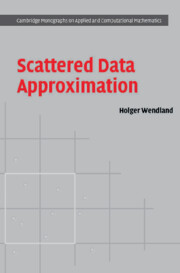Book contents
- Frontmatter
- Contents
- Preface
- 1 Applications and motivations
- 2 Haar spaces and multivariate polynomials
- 3 Local polynomial reproduction
- 4 Moving least squares
- 5 Auxiliary tools from analysis and measure theory
- 6 Positive definite functions
- 7 Completely monotone functions
- 8 Conditionally positive definite functions
- 9 Compactly supported functions
- 10 Native spaces
- 11 Error estimates for radial basis function interpolation
- 12 Stability
- 13 Optimal recovery
- 14 Data structures
- 15 Numerical methods
- 16 Generalized interpolation
- 17 Interpolation on spheres and other manifolds
- References
- Index
17 - Interpolation on spheres and other manifolds
Published online by Cambridge University Press: 22 February 2010
- Frontmatter
- Contents
- Preface
- 1 Applications and motivations
- 2 Haar spaces and multivariate polynomials
- 3 Local polynomial reproduction
- 4 Moving least squares
- 5 Auxiliary tools from analysis and measure theory
- 6 Positive definite functions
- 7 Completely monotone functions
- 8 Conditionally positive definite functions
- 9 Compactly supported functions
- 10 Native spaces
- 11 Error estimates for radial basis function interpolation
- 12 Stability
- 13 Optimal recovery
- 14 Data structures
- 15 Numerical methods
- 16 Generalized interpolation
- 17 Interpolation on spheres and other manifolds
- References
- Index
Summary
So far w have been concerned with interpolation on an arbitrary domain Ω ⊂ ℝd. However, we have not used any topological information about Ω. Instead, we have employed only the fact that it is a subset of ℝd. As a matter of fact, without having more information on Ω this is the only way. But many applications provide us with additional information on the underlying domain. For example, problems coming from geology often relate to the entire earth, so that the unit sphere would be an appropriate model and the additional information should lead to a better approximant.
Hence, in this chapter, we want to give an introduction to the theory of scattered data interpolation on spheres and other compact manifolds by radial or zonal functions.
Spherical harmonics
Generally, functions on the sphere are expressed as Fourier series with respect to an orthonormal family called spherical harmonics. In this section we will review the results on these functions. Since this material is only necessary for the present chapter we did not incorporate it into Chapter 5. Moreover, we have to skip the proofs once again. The interested reader is referred to Müller's book [140].
The domain of interest is the d-variate unit sphere Sd−1 := {x ∈ ℝd : ∥x∥2 = 1} ⊆ ℝd. It has surface area
On Sd−1, we will employ the usual inner product
where dS(x) is given by the standard measure on the sphere.
The distance between two points is the geodesic distance, which is the length of the shorter part of the great circle joining x and y or, in other words, dist(x, y) = arccos(xT y).
- Type
- Chapter
- Information
- Scattered Data Approximation , pp. 308 - 322Publisher: Cambridge University PressPrint publication year: 2004



